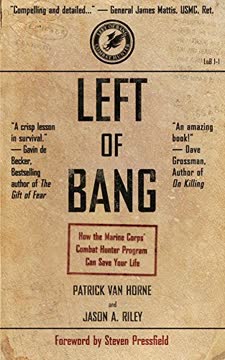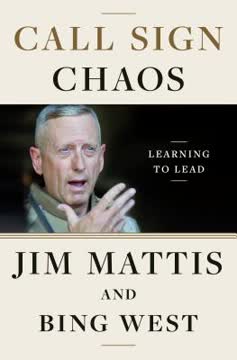Key Takeaways
1. Mental toughness is crucial for warriors and can be developed
You don't rise to the occasion, You sink to your level of training.
Mental toughness defined. Mental toughness is the ability to effectively execute and adapt decision-making and physical skills learned in training, even under high-stress conditions. It involves understanding and utilizing psychological skills that allow for maximal performance in critical situations.
Importance for warriors. For military personnel and law enforcement officers, mental toughness can mean the difference between life and death. It enables warriors to maintain focus, make sound decisions, and perform effectively even when faced with extreme pressure, fear, or fatigue.
Developing mental toughness. Unlike popular belief, mental toughness is not an innate trait but a skill that can be developed through targeted training and practice. This includes:
- Learning stress management techniques
- Enhancing concentration and attention control
- Practicing tactical performance imagery
- Developing effective self-talk strategies
- Building a positive mindset through affirmations
2. Optimal arousal level enhances performance in high-stress situations
For any skill, task or situation, there is an optimal level of arousal that leads to peak performance.
The Inverted-U Theory. This theory suggests that performance improves with increasing arousal up to an optimal point, after which further increases in arousal lead to decreased performance. Finding and maintaining this optimal level of arousal is key to peak performance in high-stress situations.
Factors affecting optimal arousal:
- Nature and complexity of the task
- Individual differences
- Level of experience with the task
Strategies for managing arousal:
- Recognize personal signs of under- and over-arousal
- Practice relaxation techniques to decrease arousal when too high
- Use activation techniques to increase arousal when too low
- Develop self-awareness to identify optimal arousal state
- Utilize pre-performance routines to achieve desired arousal level
3. Tactical breathing and relaxation techniques control stress responses
Critical to performance under stress is the ability to quickly control the stress reaction and, hence, reduce the release and effect of adrenaline on the system.
Tactical breathing. This technique involves slow, controlled breathing to manage physiological and psychological responses to stress. The basic method is:
- Inhale deeply through the nose for a count of four
- Hold the breath for a count of four
- Exhale slowly through the mouth for a count of four
- Hold empty for a count of four
- Repeat as necessary
Progressive Muscle Relaxation (PMR). This technique involves systematically tensing and relaxing different muscle groups to reduce overall body tension and promote relaxation. Regular practice can help warriors quickly induce a relaxed state even in high-stress situations.
Benefits of relaxation techniques:
- Reduce physical tension and mental stress
- Improve focus and decision-making under pressure
- Enhance recovery between high-stress events
- Increase overall resilience to stress
4. Concentration and attention control are essential skills for warriors
The ability to control attention under pressure and in response to changing demands that separates the average person from the super performer.
Types of attention:
- Broad vs. narrow focus
- Internal vs. external focus
Importance of attention flexibility. Warriors must be able to shift their attention as needed, from broad situational awareness to narrow task focus, and from internal self-monitoring to external threat assessment.
Techniques to improve concentration:
- Attention-fixation training: Practice focusing on a single object for increasing periods of time
- Distraction training: Learn to maintain focus while introducing progressively more challenging distractions
- Simulation training: Practice attention control in realistic scenarios
- Mindfulness meditation: Develop general attention control skills
- Task-specific mental rehearsal: Visualize maintaining focus during critical tasks
5. Tactical performance imagery improves skills and prepares for missions
Imagery...is the most important of the mental skills required for winning the mind game in sports.
Definition and purpose. Tactical performance imagery involves mentally rehearsing skills, scenarios, and missions to improve performance and prepare for various situations. It helps create mental models that can be quickly accessed in real situations.
Key principles for effective imagery:
- Use all senses (visual, auditory, kinesthetic, olfactory, gustatory)
- Make images as vivid and realistic as possible
- Practice from both internal (first-person) and external (third-person) perspectives
- Imagine correct, successful performance
- Include emotional and physiological responses
- Practice regularly and integrate with physical training
Benefits of tactical performance imagery:
- Enhances skill acquisition and refinement
- Improves decision-making under pressure
- Reduces performance anxiety
- Increases confidence and mental preparedness
- Maintains skills during periods of limited physical practice
6. Self-talk and thought control shape attitudes and performance
Thought precedes every action, so in order to focus the mind, you need a way to streamline your thinking.
Types of self-talk:
- Instructional: Focuses on specific task-related cues and actions
- Motivational: Boosts confidence and effort
- Negative: Undermines performance and confidence
STEP-UP (Self-Talk for Enhanced Performance - Under Pressure):
- Identify automatic negative self-talk
- Create performance-enhancing alternatives
- Practice and reinforce positive self-talk
Thought stopping technique:
- Recognize negative thought
- Mentally yell "STOP" or visualize a stop sign
- Replace with task-focused, positive self-talk
Benefits of effective self-talk:
- Improves focus and concentration
- Enhances emotional control
- Boosts confidence and resilience
- Facilitates optimal arousal levels
- Improves overall performance under pressure
7. Positive affirmations reinforce warrior mindset and values
Attitude is the advance man of our true selves. Its roots are inward, but its fruit outward.
Characteristics of effective affirmations:
- Positive statements about oneself
- Truthful and realistic
- Focused on strengths, skills, and goals
- Phrased in first-person, present tense
- Reviewed or repeated daily
Types of affirmations for warriors:
- Personal: Reinforce individual qualities and values
- Professional: Emphasize dedication to duty and unit
- Performance: Focus on skill mastery and mission readiness
Example affirmations:
- "I am mentally and physically prepared for any challenge."
- "I trust my training and ability to perform under pressure."
- "I remain calm and focused in high-stress situations."
- "I am committed to excellence in all my duties."
- "I am an essential part of a strong and dedicated team."
Benefits of using affirmations:
- Reinforce positive self-image and confidence
- Align thoughts and actions with core values
- Increase resilience in the face of adversity
- Enhance motivation and commitment to goals
- Support overall mental toughness and warrior mindset
Last updated:
FAQ
What's On Combat about?
- Psychological and Physiological Focus: On Combat by Dave Grossman examines the psychological and physiological aspects of deadly conflict, applicable in both war and peace.
- Warrior Mindset Development: It emphasizes developing a "warrior mindset" for military and law enforcement personnel, focusing on mental preparedness and resilience.
- Stress Management Techniques: The book provides techniques for managing stress, such as Tactical Muscle Relaxation and Tactical Breathing, to enhance performance under pressure.
Why should I read On Combat by Dave Grossman?
- Essential for High-Stress Professions: It's crucial for military and law enforcement personnel, offering psychological tools to handle high-stress situations effectively.
- Real-World Applications: The insights are based on empirical research and real-life experiences, making them applicable in various critical scenarios.
- Performance Enhancement: Understanding psychological factors in combat can improve decision-making and overall effectiveness in high-pressure roles.
What are the key takeaways of On Combat?
- Mental Toughness is Crucial: Success in military and police operations is largely attributed to psychological skills rather than physical abilities.
- Stress and Arousal Management: Techniques like Tactical Muscle Relaxation and Tactical Breathing are vital for controlling arousal levels and optimizing performance.
- Fear Management: Acknowledging and managing fear is essential for effective action in combat situations.
What is the Warrior Mindset as described in On Combat?
- Mental Preparedness: It involves being mentally ready for combat challenges, including stress and fear management.
- Psychological Skills Development: Focuses on enhancing decision-making and performance under pressure through skills like focus and emotional control.
- Mind-Body Integration: Success in combat requires a balance of mental and physical training.
How does On Combat define mental toughness?
- Psychological Skills Utilization: Mental toughness is the ability to understand and use psychological skills effectively under stress.
- Adaptation and Persistence: It enables individuals to adapt and persist in both everyday and high-stress environments.
- Critical for Warriors: Essential for military and law enforcement personnel to perform optimally in life-and-death situations.
What techniques does On Combat recommend for managing stress?
- Tactical Muscle Relaxation (TMR): Involves tensing and relaxing muscle groups to promote relaxation and focus during missions.
- Tactical Breathing: Controlled breathing helps manage arousal and anxiety, maintaining composure in high-stress situations.
- Imagery and Self-Talk: Using mental imagery and positive self-talk prepares individuals for challenges and boosts confidence.
What is Tactical Muscle Relaxation (TMR) as per On Combat?
- Active Relaxation Technique: TMR helps control physiological responses to stress through a physically and mentally active approach.
- Conditioning Response: Associating a command word with relaxation allows quick induction of a relaxed state.
- Immediate Application: Useful in various settings, including missions, to conserve energy and manage stress effectively.
How does On Combat address the relationship between fear and performance?
- Fear as a Natural Response: Fear is common in high-stress situations and can serve as a warning signal.
- Courage in Confronting Fear: True courage involves recognizing and managing fear, allowing effective performance despite it.
- Training to Manage Fear: Training prepares warriors to confront and control their fears, enhancing performance in critical situations.
What role does experience play in managing stress according to On Combat?
- Experience Reduces Arousal: Experienced individuals maintain lower arousal levels during high-stress situations compared to novices.
- Training and Simulation: Realistic training scenarios build experience, enhancing confidence and reducing stress responses.
- Adaptation Over Time: With experience, warriors learn to manage stress and arousal levels more effectively, improving field performance.
What is tactical self-talk, and how is it used in On Combat?
- Definition of Tactical Self-Talk: Internal dialogue guiding individuals during high-stress situations, using specific phrases to enhance focus.
- Positive Framing Importance: Self-talk should be positive and action-oriented, like "Stay calm and focused" instead of "Don't panic."
- Examples of Tactical Self-Talk: Phrases like "Breathe, Relax, Aim, Squeeze" help remember critical actions during high-pressure scenarios.
What is the significance of mental imagery in On Combat?
- Preparation for Real-Life Scenarios: Mental imagery allows rehearsal and visualization of responses to combat situations, enhancing readiness.
- Physiological Benefits: Produces physiological responses similar to actual performance, reinforcing neural pathways for executing skills.
- Vividness and Detail: Engaging all senses during imagery practice leads to better performance outcomes.
How can I apply the concepts from On Combat in my daily life?
- Practice Breathing Techniques: Use diaphragmatic breathing and the 4-count method to manage stress and improve focus in daily routines.
- Use Tactical Self-Talk: Develop positive, task-relevant self-talk habits to guide actions and decisions, enhancing performance in various situations.
- Engage in Mental Imagery: Regularly practice mental imagery to prepare for challenges, building confidence and stress-handling abilities.
Review Summary
On Combat receives mixed reviews, with many praising its insights into combat psychology and physiology. Readers appreciate the practical advice for warriors and their families. Critics note repetitiveness, lack of citations, and potential bias. Some find it essential for understanding combat stress, while others question its scientific rigor. The book's exploration of post-combat issues and breathing techniques is widely commended. Overall, it's considered valuable for military, law enforcement, and those close to them, despite some flaws in presentation and academic approach.
Similar Books






Download PDF
Download EPUB
.epub digital book format is ideal for reading ebooks on phones, tablets, and e-readers.





